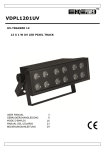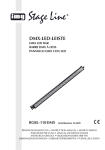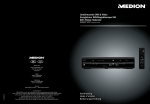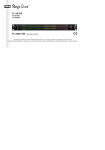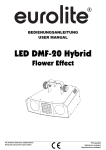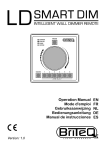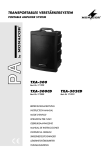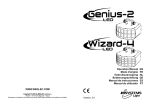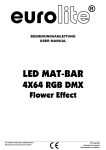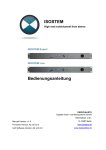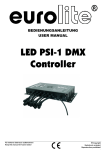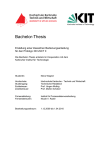Download STEUERGERÄT FÜR RGB-LED-SCHEINWERFER
Transcript
STEUERGERÄT FÜR RGB-LED-SCHEINWERFER CONTROLLER FOR RGB LED SPOTLIGHTS CONTRÔLEUR POUR PROJECTEURS RGB À LEDS CONTROLLER PER PROIETTORI A LED RGB LED-4MC Best.-Nr. 38.4370 BEDIENUNGSANLEITUNG • INSTRUCTION MANUAL MODE D’EMPLOI • ISTRUZIONI PER L’USO • GEBRUIKSAANWIJZING MANUAL DE INSTRUCCIONES • INSTRUKCJA OBSŁUGI SIKKERHEDSOPLYSNINGER • SÄKERHETSFÖRESKRIFTER • TURVALLISUUDESTA 1 2 3 4 9 5 10 6 7 11 12 8 13 2 D A CH F B CH Bevor Sie einschalten … GB Before switching on … Wir wünschen Ihnen viel Spaß mit Ihrem neuen Gerät von „img Stage Line“. Bitte lesen Sie diese Bedienungsanleitung vor dem Betrieb gründlich durch. Nur so lernen Sie alle Funktionsmöglichkeiten kennen, vermeiden Fehlbedienungen und schützen sich und Ihr Gerät vor eventuellen Schäden durch unsachgemäßen Gebrauch. Heben Sie die Anleitung für ein späteres Nachlesen auf. We wish you much pleasure with your new “img Stage Line” unit. Please read these operating instructions carefully prior to operating the unit. Thus, you will get to know all functions of the unit, operating errors will be prevented, and yourself and the unit will be protected against any damage caused by improper use. Please keep the operating instructions for later use. Der deutsche Text beginnt auf der Seite 4. The English text starts on page 7. Avant toute installation … I Nous vous souhaitons beaucoup de plaisir à utiliser cet appareil “img Stage Line”. Lisez ce mode dʼemploi entièrement avant toute utilisation. Uniquement ainsi, vous pourrez apprendre lʼensemble des possibilités de fonctionnement de lʼappareil, éviter toute manipulation erronée et vous protéger, ainsi que lʼappareil, de dommages éventuels engendrés par une utilisation inadaptée. Conservez la notice pour pouvoir vous y reporter ultérieurement. Prima di accendere … Vi auguriamo buon divertimento con il vostro nuovo apparecchio di “img Stage Line”. Leggete attentamente le istruzioni prima di mettere in funzione lʼapparecchio. Solo così potete conoscere tutte le funzionalità, evitare comandi sbagliati e proteggere voi stessi e lʼapparecchio da eventuali danni in seguito ad un uso improprio. Conservate le istruzioni per poterle consultare anche in futuro. Il testo italiano inizia a pagina 13. La version française se trouve page 10. NL B Voor u inschakelt … E Wij wensen u veel plezier met uw nieuwe apparaat van “img Stage Line”. Lees deze gebruikershandleiding grondig door, alvorens het apparaat in gebruik te nemen. Alleen zo leert u alle functies kennen, vermijdt u foutieve bediening en behoedt u zichzelf en het apparaat voor eventuele schade door ondeskundig gebruik. Bewaar de handleiding voor latere raadpleging. Antes de la utilización … Le deseamos una buena utilización para su nuevo aparato “img Stage Line”. Por favor, lea estas instrucciones de uso atentamente antes de hacer funcionar el aparato. De esta manera conocerá todas las funciones de la unidad, se prevendrán errores de operación, usted y el aparato estarán protegidos en contra de todo daño causado por un uso inadecuado. Por favor, guarde las instrucciones para una futura utilización. De Nederlandstalige tekst vindt u op pagina 16. La versión española comienza en la página 19. PL Przed uruchomieniem … DK Życzymy zadowolenia z nowego produktu “img Stage Line”. Dzięki tej instrukcji obsługi będą państwo w stanie poznać wszystkie funkcje tego urządzenia. Stosując się do instrukcji unikną państwo błędów i ewentualnego uszkodzenia urządzenia na skutek nieprawidłowego użytkowania. Prosimy zachować instrukcję. Før du tænder … Tillykke med dit nye “img Stage Line” produkt. Læs sikkerhedsanvisningerne nøje før ibrugtagning, for at beskytte Dem og enheden mod skader, der skyldes forkert brug. Gem manualen til senere brug. Sikkerhedsanvisningerne findes på side 26. Tekst polski zaczyna się na stronie 22. S Innan du slår på enheten … Vi önskar dig mycket glädje med din nya “img Stage Line” produkt. Läs igenom säkerhetsföreskrifterna innan enheten tas i bruk för att undvika skador till följd av felaktig hantering. Behåll instruktionerna för framtida bruk. Säkerhetsföreskrifterna återfinns på sidan 26. FIN Ennen kytkemistä … Toivomme Sinulle paljon miellyttäviä hetkiä uuden “img Stage Line” laitteen kanssa. Ennen laitteen käyttöä pyydämme Sinua huolellisesti tutustumaan turvallisuusohjeisiin. Näin vältyt vahingoilta, joita virheellinen laitteen käyttö saattaa aiheuttaa. Ole hyvä ja säilytä käyttöohjeet myöhempää tarvetta varten. Turvallisuusohjeet löytyvät sivulta 27. ® w w w.imgstageline.com 3 D A Auf der Seite 2 finden Sie alle beschriebenen Bedienelemente und Anschlüsse. CH 1 Übersicht der Bedienelemente und Anschlüsse 2 1 DMX-Signal-Ausgang (3-pol. XLR) zum Anschluss der zu steuernden RGB-LED-Scheinwerfer; Kontaktbelegung: 1 = Masse, 2 = DMX-, 3 = DMX+ WARNUNG Das Netzgerät wird mit lebensgefährlicher Netzspannung versorgt. Nehmen Sie deshalb niemals selbst Eingriffe daran vor! Es besteht die Gefahr eines elektrischen Schlages. 2 Wahlschalter für die Anzahl der Scheinwerfer Beachten Sie auch unbedingt die folgenden Punkte: 3 Kleinspannungsbuchse DC IN 12V mit Verriegelung zum Anschluss des mitgelieferten Steckernetzgerätes G Verwenden Sie die Geräte nur im Innenbereich und schützen Sie sie vor Tropf- und Spritzwasser, hoher Luftfeuchtigkeit und Hitze (zulässiger Einsatztemperaturbereich 0 – 40 °C). G Nehmen Sie das Steuergerät nicht in Betrieb oder ziehen Sie sofort das Netzgerät aus der Steckdose, 1. wenn sichtbare Schäden am Steuergerät oder am Netzgerät vorhanden sind, 2. wenn nach einem Sturz oder Ähnlichem der Verdacht auf einen Defekt besteht, 3. wenn Funktionsstörungen auftreten. Geben Sie die Geräte in jedem Fall zur Reparatur in eine Fachwerkstatt. 7 Taste PTN zur Wahl eines Sequenzmusters im Sequenzmodus G Verwenden Sie für die Reinigung nur ein trockenes, weiches Tuch, niemals Wasser oder Chemikalien. 8 Taste MODE zum Umschalten der Betriebsart G Werden die Geräte zweckentfremdet, falsch angeschlossen, nicht richtig bedient oder nicht fachgerecht repariert, kann keine Haftung für daraus resultierende Sach- oder Personenschäden und keine Garantie für die Geräte übernommen werden. 4 Ein-/Ausschalter ON/ OFF 5 Taste DIMMER zum Einstellen der Gesamthelligkeit; die aktuelle Einstellung wird über die drei LEDs „50 %“, „75 %“ und „100 %“ angezeigt 6 Taste TRANSITION zur Wahl der Szenenwechsel im Sequenzmodus; die aktuelle Einstellung wird über die beiden LEDs angezeigt „HARD“ = abrupter Wechsel „SOFT“ = Überblendung Statische Farben: LED „SCENE“ leuchtet Sequenzmodus: LED „SCENE“ leuchtet nicht 9 Mikrofon für den musikgesteuerten Sequenzbetrieb Sollen die Geräte endgültig aus dem Betrieb genommen werden, übergeben Sie sie zur umweltgerechten Entsorgung einem örtlichen Recyclingbetrieb. 10 Taste TAP zum Umschalten zwischen zeitgesteuertem und musikgesteuertem Sequenzbetrieb 11 Taste COL zur Wahl der Farbe oder Farbkombination im statischen Betrieb und im Sequenzbetrieb 12 Taste B/O mit Kontroll-LED zum Dunkelschalten aller Scheinwerfer (Blackout); zum Zurückschalten auf den vorherigen Modus die Taste erneut drücken 13 Taste STROBE mit Kontroll-LED „ON“ zum Aktivieren der scheinwerfereigenen Stroboskopfunktion; zum Zurückschalten auf den vorherigen Modus die Taste erneut drücken 4 Hinweise für den sicheren Gebrauch Die Geräte (Steuergerät und Netzgerät) entsprechen allen erforderlichen Richtlinien der EU und sind deshalb mit gekennzeichnet. 3 Einsatzmöglichkeiten Das LED-4MC ist für die einfache Steuerung von RGB-LED-Scheinwerfern vorgesehen. Es kann die Modelle PARL-1RGB/… und PARL-10RGB/… steuern und weitere Scheinwerfer, die über die folgende Belegung der DMX-Kanäle verfügen: DMX-Wert Funktion Kanal 1: Rot-Anteil 0 – 255 Helligkeit Rot Kanal 2: Grün-Anteil 0 – 255 Helligkeit Grün Kanal 3: Blau-Anteil 0 – 255 Helligkeit Blau Kanal 4: Dimmer und Stroboskop 0 – 127 Dimmer 128 – 227 Stroboskop: langsam → schnell 228 – 255 maximale Helligkeit, Stroboskop aus Ebenso können mit dem LED-4MC Scheinwerferkombinationen mit einer gemeinsamen Steuerung (z. B. PARL-40SET) oder LED-Panels (z. B. RGBL-110DMX) bedient werden, wenn darin die einzelnen Scheinwerfer bzw. Segmente jeweils über das gezeigte Kanalschema aufeinanderfolgend steuerbar sind (Scheinwerfer/ Segment 1: Kanal 1 – 4, Scheinwerfer/ Segment 2: Kanal 5 – 8, usw.). Das Steuergerät kann statische Szenen, d. h. feste Farben oder Farbkombinationen und wechselnde Szenen (Sequenzen) erzeugen. Die Wechsel der Szenen einer Sequenz erfolgt nach vorgegebener Zeit oder durch Musikimpulse über das integrierte Mikrofon. Ob eine 3er- oder 4er-Scheinwerferkombinationen verwendet wird, kann per Schalter festgelegt werden. Zusätzlich sind eine Blackout-Funktion und ein Stroboskop-Effekt abrufbar. 4 sprechenden Abschlussstecker (z. B. DLT-123 von „img Stage Line“) verwenden. 4.2 Anzahl der Scheinwerfer einstellen D A CH Mit dem Schalter 3-MODE-4 (2) wählen, ob 3 oder 4 Scheinwerfer angeschlossen sind. Entsprechend für die Steuerung eines PARL-40SET die Position „4“, für die eines RGBL-110DMX die Position „3“ wählen. Die Einstellung hat nur Einfluss auf die Art der Sequenzmuster (z. B. Lauflicht). 4.3 DMX-Adressen einstellen Bei der Verwendung einzelner Scheinwerfer an diesen die folgenden DMX-Startadressen einstellen: 1. Scheinwerfer: Startadresse 1 2. Scheinwerfer: Startadresse 5 3. Scheinwerfer: Startadresse 9 4. Scheinwerfer: Startadresse 13 Um weitere Scheinwerfer synchron zu steuern, diese auf dieselben Startadressen einstellen. 4.4 Stromversorgung anschließen Das beiliegende Steckernetzgerät mit der Kleinspannungsbuchse DC IN 12V (3) verbinden und in eine Netzsteckdose (100 – 240 V~/50 – 60 Hz) stecken. Der Stecker ist in der Buchse gegen versehentliches Herausziehen verriegelbar. Beim Einstecken den Stecker so halten, dass seine „Ohren“ in die seitlichen Aussparungen der Buchse passen. Den Stecker zum Verriegeln nach dem Einstecken 90° im Uhrzeigersinn drehen. Inbetriebnahme 4.1 LED-Scheinwerfer anschließen 5 Den Ausgang (1) des Steuergerätes mit dem DMXEingang des ersten RGB-LED-Scheinwerfers verbinden. Zum Anschluss sollten spezielle Kabel für hohen Datenfluss verwendet werden. Normale abgeschirmte Mikrofonkabel mit einem Leitungsquerschnitt von mindestens 2 × 0,22 mm2 und möglichst geringer Kapazität sind nur bei einer Gesamtkabellänge bis 100 m zu empfehlen. Bei Leitungslängen ab 150 m wird grundsätzlich das Zwischenschalten eines DMX-Aufholverstärkers empfohlen (z. B. SR-103DMX von „img Stage Line“). Den DMX-Eingang eines zweiten Scheinwerfers mit dem Ausgang des ersten Scheinwerfers verbinden. An den Ausgang des zweiten Scheinwerfers den dritten anschließen usw., bis alle Scheinwerfer in einer Kette angeschlossen sind. Den Ausgang des letzten Scheinwerfers für einen störungsfreien Betrieb mit einem 120-Ω-Abschlusswiderstand (> 0,3 W) versehen: An die Pins 2 und 3 eines XLR-Steckers den Widerstand anlöten und den Stecker in den DMX-Ausgang stecken oder einen ent- Das Steuergerät mit dem Schalter ON/ OFF (4) einschalten. Nach dem Einschalten hat das Steuergerät die zuletzt gewählte Einstellung, wenn diese mindestens 3 s vor dem Ausschalten bestand. Bedienung 5.1 Statische Farben 1) Leuchtet die LED „SCENE“ unter der Taste MODE (8) nicht, die Taste drücken, sodass die LED leuchtet. 2) Ist eine der Funktionen B/O oder STROBE aktiv [die LED unter der Taste (12 oder 13) leuchtet], diese mit der entsprechenden Taste deaktivieren. 3) Durch (wiederholtes) Drücken der Taste COL (11) die gewünschte Farbe oder Farbkombination auswählen. 5.2 Sequenzmodus 1) Leuchtet die LED „SCENE“ unter der Taste MODE (8), die Taste drücken, sodass die LED erlischt. 5 D A CH 2) Ist eine der Funktionen B/O oder STROBE aktiv [die LED unter der Taste (12 oder 13) leuchtet], diese mit der entsprechenden Taste deaktivieren. 3) Durch (wiederholtes) Drücken der Taste PTN (7) eines der vorgegebenen Sequenzmuster (z. B. Lauflicht) auswählen. 4) Durch (wiederholtes) Drücken der Taste COL (11) kann die Farbe oder Farbkombination des gewählten Sequenzmusters geändert werden. 5) Mit der Taste TAP (10) die Art der Sequenzsteuerung auswählen: 1 × drücken: die Szenen des gewählten Sequenzmusters werden durch ausreichend laute Musikimpulse über das Mikrofon (9) weitergeschaltet, die LED „S2L“ leuchtet 2) Zum Aktivieren der Stroboskop-Funktion die Taste STROBE (13) drücken. Die LED „ON“ leuchtet. Unabhängig von der Einstellung mit der Taste DIMMER (5) blitzen die Scheinwerfer immer mit maximaler Helligkeit (Blitzfrequenz ca. 16 Hz). 3) Zum Deaktivieren die Taste STROBE erneut drücken. Die LED „ON“ erlischt. Hinweis: Die Stroboskop-Funktion wird nicht im Steuergerät erzeugt, sondern es wird über die Ausgabe eines bestimmten DMX-Wertes im 4. Kanal jedes Scheinwerfers die scheinwerfereigene StroboskopFunktion aufgerufen. Verfügt ein Scheinwerfer nicht über eine entsprechende Funktion, ist so kein Stroboskop-Effekt möglich. 5.5 Blackout-Funktion 2 × drücken (zwischen den Tastendrücken nicht länger als 1 s warten): die Szenen des gewählten Sequenzmusters werden automatisch ca. alle 3 Sekunden weitergeschaltet, die LED „S2L“ leuchtet nicht Mit der Blackout-Funktion können alle Scheinwerfer vorübergehend dunkelgeschaltet werden. 4 × drücken (oder häufiger, zwischen den Tastendrücken nicht länger als 1 s warten): die Szenen des gewählten Sequenzmusters werden automatisch im durchschnittlichen Abstand der Tastendrücke weitergeschaltet, die LED „S2L“ leuchtet nicht 2) Zum Deaktivieren der Funktion die Taste erneut drücken. Die LED erlischt und der vorherige Betriebsmodus wird wiederhergestellt. 6) Mit der Taste TRANSITION (6) die Art des Szenenwechsels wählen. Die aktuelle Einstellung wird mit den LEDs angezeigt: „HARD“ = abrupter Wechsel „SOFT“ = Überblendung Hinweis: Für die Steuerung über das Mikrofon hat diese Einstellung keine Bedeutung, der Wechsel erfolgt hier immer abrupt. 1) Zum Aktivieren der Blackout-Funktion die Taste B/O (12) drücken. Alle Scheinwerfer werden dunkelgeschaltet und die LED unter der Taste leuchtet. Es ist auch möglich, während der Blackout-Funktion einen anderen Betriebsmodus auszuwählen, der dann nach Beenden der Blackout-Funktion aktiv wird. 5.6 Nach dem Gebrauch Das Steuergerät mit dem Schalter ON/ OFF (4) ausschalten. Bei längerem Nichtgebrauch zur Vermeidung unnötigen Stromverbrauchs das Steckernetzgerät aus der Netzsteckdose ziehen. 6 5.3 Gesamthelligkeit wählen Mit der Taste DIMMER (5) kann die Gesamthelligkeit gewählt werden. Durch wiederholtes Drücken wird zwischen „50 %“, „75 %“ und „100 %“ umgeschaltet. Die drei LEDs zeigen die aktuelle Einstellung an. Technische Daten Stromversorgung: . . . 12 V /100 mA über mitgeliefertes Steckernetzgerät an 100 – 240 V~/50 – 60 Hz DMX-Kanäle: . . . . . . . 16 Abmessungen: . . . . . . 71 mm × 35 mm × 113 mm 5.4 Stroboskop-Funktion 1) Ist die Funktionen B/O aktiv [die LED unter der Taste (12) leuchtet], diese mit der Taste deaktivieren. Gewicht: . . . . . . . . . . . 310 g Änderungen vorbehalten. Diese Bedienungsanleitung ist urheberrechtlich für MONACOR ® INTERNATIONAL GmbH & Co. KG geschützt. Eine Reproduktion für eigene kommerzielle Zwecke – auch auszugsweise – ist untersagt. 6 All operating elements and connections described can be found on page 2. 2 1 WARNING Operating Elements and Connections Safety Notes 1 DMX signal output (3-pole XLR) to connect the RGB LED spotlights to be controlled; pin configuration: 1 = ground, 2 = DMX-, 3 = DMX+ The power supply unit uses dangerous mains voltage. Leave servicing to skilled personnel only. Inexpert handling or modification of the unit may result in electric shock. 2 Selector switch for the number of spotlights Please observe the following items in any case: 3 Low voltage jack DC IN 12V with latching to connect the plug-in power supply unit provided G The units are suitable for indoor use only. Protect them against dripping water and splash water, high air humidity and heat (admissible ambient temperature range 0 – 40 °C). G Do not operate the controller and immediately disconnect the power supply unit from the socket 1. if the controller or the power supply unit is visibly damaged, 2. if a defect might have occurred after a unit was dropped or suffered a similar accident, 3. if malfunctions occur. In any case the units must be repaired by skilled personnel. 7 Button PTN to select a sequence pattern in the sequence mode G For cleaning only use a dry, soft cloth; never use water or chemicals. 8 Button MODE to select the operating mode G No guarantee claims for the units and no liability for any resulting personal damage or material damage will be accepted if the units are used for other purposes than originally intended, if they are not correctly connected or operated, or if they are not repaired in an expert way. 4 ON/OFF switch 5 Button DIMMER to set the total brightness; the current setting will be indicated via the three LEDs “50 %”, “75 %” and “100 %” 6 Button TRANSITION to select the change of scenes in the sequence mode; the current setting will be indicated via the two LEDs “HARD” = sudden change “SOFT” = transition static colours: GB The units (controller and power supply unit) correspond to all required directives of the EU and are therefore marked with . LED “SCENE” will light up sequence mode: LED “SCENE” will not light up 9 Microphone for the music-controlled sequence mode 10 Button TAP to switch between time-controlled and music-controlled sequence mode If the units are to be put out of operation definitively, take them to a local recycling plant for a disposal which will not be harmful to the environment. 11 Button COL to select the colour or colour combination in the static mode and in the sequence mode 12 Button B / O with indicating LED for blackout of all spotlights; to return to the previous mode, press the button once again 3 13 Button STROBE with indicating LED “ON” to activate the stroboscope function of the spotlight; to return to the previous mode, press the button once again LED-4MC has been designed for easy control of RGB LED spotlights. It is capable of controlling the models PARL-1RGB/… and PARL-10RGB/… and further spotlights with the following configuration of DMX channels: Applications 7 GB DMX value Function Channel 1: proportion of red 0 – 255 brightness of red Channel 2: proportion of green 0 – 255 brightness of green 4.2 Setting the number of spotlights With the switch 3-MODE-4 (2), define if 3 or 4 spotlights have been connected. Accordingly, select the position “4” for controlling PARL-40SET or “3” for controlling RGBL-110DMX. The setting will only affect the type of sequence pattern (e. g. running light). Channel 3: proportion of blue 0 – 255 brightness of blue Channel 4: dimmer and stroboscope 0 – 127 dimmer 128 – 227 stroboscope: slow → fast 228 – 255 maximum brightness, stroboscope off LED-4MC will also be able to operate spotlight combinations with a common control (e. g. PARL-40SET) or LED panels (e. g. RGBL-110DMX) if they allow successive control of the individual spotlights or segments via the channel diagram above (spotlight / segment 1: channels 1 – 4, spotlight / segment 2: channels 5 – 8, etc.). The controller will be able to create static scenes, i. e. fixed colours or colour combinations and changing scenes (sequences). The scenes of a sequence will change after a preset time or by music pulses via the integrated microphone. A selector switch is provided to define if a combination of 3 or 4 spotlights is used. In addition, a blackout function and a stroboscope effect will be available. 4 Setting the Controller in Operation 4.3 Setting DMX addresses When using individual spotlights, set the following DMX start addresses on these spotlights: First spotlight: start address 1 Second spotlight: start address 5 Third spotlight: start address 9 Fourth spotlight: start address 13 To synchronize further spotlights, set these spotlights to the same start addresses. 4.4 Connecting the power supply Connect the plug-in power supply unit provided to the low voltage jack DC IN 12V (3) and to a mains socket (100 – 240 V~/50 – 60 Hz). To prevent accidental disconnection, the plug will latch in the plug. When inserting the plug, hold it in such a way that its “ears” fit into the lateral recesses of the jack. After inserting, turn the plug clockwise by 90° to latch it. 5 Operation Switch on the controller with the switch ON / OFF (4). After switching on, the controller will have the last setting selected, provided that this setting existed for a minimum of 3 seconds before the controller was switched off. 4.1 Connecting LED spotlights Connect the output (1) of the controller to the DMX input of the first RGB LED spotlight. For connection, special cables for high data flow should be used. Standard microphone cables with screening and a minimum cross section of 2 × 0.22 mm2 and with a capacity as low as possible can only be recommended for a total cable length of up to 100 m. For cable lengths exceeding 150 m it is always recommended to insert a DMX level matching amplifier (e. g. SR-103DMX by “img Stage Line”). Connect the DMX input of a second spotlight to the output of the first spotlight. Connect the third spotlight to the output of the second spotlight etc. until all spotlights have been connected in a chain. For interference-free operation, terminate the output of the last spotlight with a 120 Ω resistor (> 0.3 W): Solder the resistor to the pins 2 and 3 of an XLR plug and connect the plug to the DMX output or use a corresponding terminating plug (e. g. DLT-123 from “img Stage Line”). 8 5.1 Static colours 1) If the LED “SCENE” below the button MODE (8) does not light up, press the button so that the LED will light up. 2) If one of the functions B / O or STROBE is active [the LED below the button (12 or 13) will light up], deactivate it with the corresponding button. 3) Press the button COL (11) [repeatedly] to select the desired colour or colour combination. 5.2 Sequence mode 1) If the LED “SCENE” below the button MODE (8) lights up, press the button so that the LED will be extinguished. 2) If one of the functions B/O or STROBE is active [the LED below the button (12 or 13) will light up], deactivate it with the corresponding button. 3) Press the button PTN (7) [repeatedly] to select one of the preset sequence patterns (e. g. running light). 4) Press the button COL (11) [repeatedly] to change the colour or colour combination of the sequence pattern selected. 3) To deactivate this function, press the button STROBE once again. The LED “ON” will be extinguished. 5) Press the button TAP (10) to select the type of sequence control: Note: The stroboscope function will not be created in the controller; the individual stroboscope function of each spotlight will be activated via the output of a particular DMX value in the fourth channel of the spotlight. If a spotlight is not provided with a corresponding function, no stroboscope effect will be possible. button pressed once: the scenes of the sequence pattern selected will change by music pulses of sufficient volume via the microphone (9), the LED “S2L” will light up button pressed twice (do not wait for more than one second before pressing the button again): the scenes of the sequence pattern selected will change automatically approx. every 3 seconds, the LED “S2L” will not light up button pressed four times (or more often, do not wait for more than one second before pressing the button again): the scenes of the sequence pattern selected will change automatically at the average time between pressing the button, the LED “S2L” will not light up 6) Define the change of scene with the button TRANSITION (6). The LEDs will indicate the current setting: GB 5.5 Blackout function With the blackout function, a temporary blackout of all spotlights will be possible. 1) To activate the blackout function, press the button B / O (12). A blackout of all spotlights will result and the LED below the button will light up. 2) To deactivate the function, press the button once again. The LED will be extinguished and the controller will return to the previous operating mode. It will also be possible to select another operating mode during the blackout function. This mode will be activated after deactivating the blackout function. “HARD” = sudden change “SOFT” = transition 5.6 After use Note: For control via microphone, this setting will not have any effect; there will always be a sudden change in this case. Switch off the controller with the switch ON / OFF (4). If the controller is not used for a longer period, disconnect the plug-in power supply unit from the mains socket to prevent unnecessary power consumption. 5.3 Selecting the total brightness The button DIMMER (5) will define the total brightness. Press it repeatedly to switch the brightness between “50 %”, “75 %” and “100 %”. The three LEDs will indicate the current setting. 5.4 Stroboscope function 1) If the function B / O is active [the LED below the button (12) will light up], deactivate it with the button. 2) To activate the stroboscope function, press the button STROBE (13). The LED “ON” will light up. Regardless of the setting with the button DIMMER (5), the spotlights will always flash at maximum brightness (flash frequency: 16 Hz approx.). 6 Specifications Power supply: . . . . . . 12 V /100 mA via plug-in power supply unit provided and connected to 100 – 240 V~/50 – 60 Hz DMX channels: . . . . . 16 Dimensions: . . . . . . . . 71 mm × 35 mm × 113 mm Weight: . . . . . . . . . . . 310 g Subject to technical modification. All rights reserved by MONACOR ® INTERNATIONAL GmbH & Co. KG. No part of this instruction manual may be reproduced in any form or by any means for any commercial use. 9 F B Vous trouverez page 2, lʼensemble des éléments et branchements. CH 1 Eléments et branchements 2 AVERTISSEMENT Le bloc secteur est alimenté par une tension dangereuse. Ne touchez jamais lʼintérieur de lʼappareil ! Risque de décharge électrique ! 1 Sortie de signal DMX (XLR, 3 pôles) pour brancher les projecteurs RBG à LEDs à gérer : pin 1 = masse, 2 = DMX-, 3 = DMX+ 2 Sélecteur pour le nombre de projecteurs 3 Prise basse tension DC IN 12V avec verrouillage pour brancher le bloc secteur livré Respectez scrupuleusement les points suivants : G Les appareils ne sont conçus que pour une utilisation en intérieur. Protégez-les de tout type de projections dʼeau, des éclaboussures, dʼune humidité élevée dʼair et de la chaleur (plage de température de fonctionnement autorisée : 0 – 40 °C). G Ne faites pas fonctionner le contrôleur ou débranchez immédiatement le bloc secteur du secteur lorsque : 1. des dommages apparaissent sur le contrôleur ou le bloc secteur, 2. après une chute ou un cas similaire, vous avez un doute sur lʼétat de lʼappareil, 3. des dysfonctionnements apparaissent. Dans tous les cas, les dommages doivent être réparés par un technicien spécialisé. G Pour le nettoyage, utilisez uniquement un chiffon sec et doux, en aucun cas de produits chimiques ou dʼeau. G Nous déclinons toute responsabilité en cas de dommages matériels ou corporels résultants si les appareils sont utilisés dans un but autre que celui pour lequel ils ont été conçus, sʼils ne sont pas correctement branchés ou utilisés ou sʼils ne sont pas réparés par une personne habilitée, en outre, la garantie deviendrait caduque. 4 Interrupteur Marche /Arrêt ON / OFF 5 Touche DIMMER pour régler la luminosité totale ; le réglage actuel est affiché via les trois LEDs “50 %”, “75 %” et “100 %”. 6 Touche TRANSITION pour sélectionner le changement de scènes en mode séquence : le réglage actuel est indiqué via les deux LEDs “HARD” = changement abrupt “SOFT” = transition souple 7 Touche PTN pour sélectionner un modèle de séquence en mode séquence 8 Touche MODE pour commuter le mode de fonctionnement : couleurs statiques : la LED “SCENE” brille mode séquence : la LED “SCENE” ne brille pas 9 Microphone pour le mode séquence géré par la musique 10 Touche TAP pour commuter entre les modes séquence programmé et géré par la musique 11 Touche COL pour sélectionner la couleur ou la combinaison de couleurs en mode statique et en mode séquence Lorsque les appareils sont définitivement retirés du service, vous devez les déposer dans une usine de recyclage adaptée pour contribuer à leur élimination non polluante. 12 Touche B / O avec LED de contrôle pour couper tous les projecteurs (Blackout) ; pour revenir au mode précédent, appuyez une nouvelle fois sur la touche. 13 Touche STROBE avec LED de contrôle “ON” pour activer la fonction stroboscope propre à chaque projecteur : pour revenir au mode précédent, appuyez une nouvelle fois sur la touche. 10 Conseils dʼutilisation et de sécurité Les appareils (contrôleur et bloc secteur) répondent à toutes les directives nécessaires de lʼUnion européenne et portent donc le symbole . 3 Possibilités dʼutilisation Le LED-4MC est prévu pour une gestion simple de projecteurs RGB à LEDs. Il peut gérer les modèles PARL-1RGB /... et PARL-10RGB /... et dʼautres projecteurs disposant de la configuration de canaux DMX suivante : Valeur DMX Fonction canal 1 : part de rouge 0 – 255 luminosité rouge canal 2 : part de vert 0 – 255 luminosité vert canal 3 : part de bleu 0 – 255 4.2 Réglage du nombre de projecteurs Avec le sélecteur 3-MODE-4 (2) sélectionnez si 3 ou 4 projecteurs sont reliés ; pour contrôler un PARL40SET, sélectionnez la position “4”, pour contrôler un RGBL-110DMX, la position “3”. Le réglage influe uniquement sur le type de modèles de séquence (par exemple lumière défilante). B CH luminosité bleu canal 4 : dimmer et stroboscope 0 – 127 dimmer 128 – 227 stroboscope : lent → rapide 228 – 255 luminosité maximale, stroboscope éteint De même, on peut utiliser avec le LED-4MC des combinaisons de projecteurs avec une gestion commune (par exemple PARL-40SET) ou des panneaux à LEDs (par exemple RGBL-110DMX) sʼils permettent un contrôle successif de chaque projecteur ou panneau selon le schéma de canal indiqué (projecteur / segment 1 : canaux 1 – 4, projecteur / segment 2 : canaux 5 – 8, et ainsi de suite). Le contrôleur peut créer des scènes statiques, cʼest-àdire des couleurs ou des combinaisons de couleurs fixes et des scènes changeantes (séquences). Les changements de scènes dʼune séquence sʼeffectuent après une durée programmée ou par des impulsions de musique via le microphone intégré. Un sélecteur est prévu pour définir si on utilise une combinaison de trois ou quatre projecteurs. On peut également activer une fonction Blackout et un effet stroboscope. 4.3 Réglage des adresses DMX Si vous utilisez des projecteurs individuels, réglez-les avec les adresses DMX de démarrage suivantes : projecteur 1 : adresse de démarrage 1 projecteur 2 : adresse de démarrage 5 projecteur 3 : adresse de démarrage 9 projecteur 4 : adresse de démarrage 13 Pour gérer dʼautres projecteurs de manière synchrone, réglez-les sur les mêmes adresses de démarrage. 4.4 Branchement de lʼalimentation Reliez le bloc secteur livré à la prise basse tension DC IN 12V (3) et à une prise secteur 100 – 240 V~ / 50 – 60 Hz. La fiche est verrouillable dans la prise pour empêcher quʼelle ne soit retirée par inadvertance. Lorsque vous branchez la fiche, tenez-la de telle sorte que ses “oreilles” rentrent dans les encoches latérales de la prise. Une fois insérée, tournez la fiche de 90° dans le sens des aiguilles dʼune montre pour la verrouiller. 5 4 F Fonctionnement 4.1 Branchement des projecteurs à LEDs Reliez la sortie (1) du contrôleur à lʼentrée DMX du premier projecteur RGB à LEDs. Pour le branchement, il est recommandé dʼutiliser des câbles spécifiques pour des flots importants de données. Des câbles micro usuels avec un blindage et une section minimum de 2 × 0,22 mm2 et une capacité la plus faible possible ne peuvent être recommandés que pour des longueurs de câble de 100 m maximum. Pour des longueurs de liaison à partir de 150 m, il est recommandé dʼinsérer un amplificateur DMX de signal (par exemple SR-103DMX de “img Stage Line”). Reliez lʼentrée DMX du deuxième projecteur à la sortie du premier. Reliez le troisième projecteur à la sortie du deuxième et ainsi de suite jusquʼà ce que tous les projecteurs soient reliés en une chaîne. Pour un fonctionnement sans interférences, placez à la sortie du dernier projecteur une résistance terminale 120 Ω (> 0,3 W) : soudez la résistance aux pins 2 et 3 dʼune fiche XLR et branchez la fiche à la sortie DMX ou utilisez un bouchon correspondant (par exemple DLT-123 de “img Stage Line”). Utilisation Allumez le contrôleur avec lʼinterrupteur ON / OFF (4). Une fois allumé, le contrôleur propose le dernier réglage sélectionné lorsque ce dernier était actif 3 secondes au moins avant lʼarrêt. 5.1 Couleurs statiques 1) Si la LED “SCENE” sous la touche MODE (8) ne brille pas, appuyez sur la touche pour que la LED brille. 2) Si une des fonctions B / O ou STROBE est activé [la LED sous la touche (12 ou 13) brille], désactivezla avec la touche correspondante. 3) Par une pression (répétée) sur la touche COL (11), sélectionnez la couleur ou la combinaison de couleurs souhaitée. 5.2 Mode séquence 1) Si la LED “SCENE” sous la touche MODE (8) brille, appuyez sur la touche pour que la LED sʼéteigne. 2) Si une des fonctions B / O ou STROBE est activé [la LED sous la touche (12 ou 13) brille], désactivez-la avec la touche correspondante. 11 F B CH 3) Par une pression (répétée) sur la touche PTN (7), sélectionnez un des modèles de séquence proposés (par exemple lumière défilante). 4) Par une pression (répétée) sur la touche COL (11), sélectionnez la couleur ou la combinaison de couleurs du modèle de séquence choisi. 5) Avec la touche TAP (10), sélectionnez le type de gestion des séquences : 1 × pression : les scènes du modèle de séquence choisi sont changées par des impulsions de musique suffisamment fortes via le micro (9) ; la LED “S2L” brille 2 × pression (entre chaque pression, ne pas attendre plus de 1 seconde) : les scènes du modèle de séquence choisi sont changées automatiquement toutes les trois secondes environ, la LED “S2L” ne brille pas 4 × pression (ou davantage, entre chaque pression, ne pas attendre plus de 1 seconde) : les scènes du modèle de séquence choisi sont changées automatiquement à intervalle moyen des activations de la touche, la LED “S2L” ne brille pas. 6) Avec la touche TRANSITION (6), sélectionnez le type de changement de scène. Le réglage actuel est indiqué par les LEDs : damment du réglage effectué avec la touche DIMMER (5), les projecteurs émettent des éclairs toujours avec une luminosité maximale (fréquence des éclairs 16 Hz environ). 3) Pour désactiver la fonction, appuyez une nouvelle fois sur la touche STROBE, la LED “ON” sʼéteint. Remarque : La fonction stroboscope nʼest pas créée dans le contrôleur, la fonction stroboscope propre à chaque projecteur est activée via lʼémission dʼune valeur DMX donnée dans le canal 4 de chaque projecteur ; si le projecteur ne dispose pas de fonction correspondante, aucun effet stroboscope nʼest possible. 5.5 Fonction Blackout Avec la fonction Blackout, tous les projecteurs peuvent être coupés temporairement. 1) Pour activer la fonction Blackout, appuyez sur la touche B / O (12). Tous les projecteurs sont coupés, la LED sous la touche brille. 2) Pour désactiver la fonction, appuyez une nouvelle fois sur la touche. La LED sʼéteint, le mode de fonctionnement précédent est rétabli. Il est également possible de sélectionner un autre mode de fonctionnement pendant la fonction Blackout, il est actif une fois la fonction Blackout désactivée. “HARD” = changement abrupt “SOFT” = transition souple 5.6 Après utilisation Remarque : Pour une gestion via le microphone, ce réglage nʼa pas dʼimportance, le changement sʼeffectue toujours de manière abrupte. Eteignez le contrôleur avec lʼinterrupteur ON / OFF (4). En cas de non utilisation prolongée, débranchez le bloc secteur de la prise secteur pour éviter toute consommation inutile. 5.3 Sélection de la luminosité totale Avec la touche DIMMER (5), vous pouvez sélectionner la luminosité totale. Par une pression répétée, vous pouvez commuter entre une luminosité de “50 %”, “75 %” ou “100 %”. Les trois LEDs indiquent le réglage actuel. 6 Caractéristiques techniques Alimentation : . . . . . . . 12 V /100 mA par bloc secteur livré relié au secteur 100 – 240 V~/50 – 60 Hz Canaux DMX : . . . . . . 16 5.4 Fonction stroboscope Dimensions : . . . . . . . 71 mm × 35 mm × 113 mm 1) Si la fonction B / O est activée [la LED sous la touche (12) brille], désactivez-la avec la touche correspondante. Poids : . . . . . . . . . . . . 310 g 2) Pour activer la fonction stroboscope, appuyez sur la touche STROBE (13). La LED “ON” brille. Indépen- Tout droit de modification réservé. Notice dʼutilisation protégée par le copyright de MONACOR ® INTERNATIONAL GmbH & Co. KG. Toute reproduction même partielle à des fins commerciales est interdite. 12 A pagina 2 trovate tutti gli elementi di comando e collegamenti descritti. 1 Elementi di comando e collegamenti 2 AVVERTIMENTO 1 Uscita dei segnali DMX (XLR a 3 poli) per il collegamento dei proiettori a LED RGB da comandare; piedinatura: 1 = massa, 2 = DMX-, 3 = DMX+ 2 Selettore per il numero dei proiettori 3 Presa alimentazione DC IN 12V con blocco per il collegamento del alimentatore a spina in dotazione 5 Tasto DIMMER per regolare la luminosità globale; lʼimpostazione attuale è indicata tramite tre LED “50 %”, “75 %” e “100 %” = cambio improvviso = dissolvenza 7 Tasto PTN per la scelta di un disegno nel modo sequenziale Usare gli apparecchi solo allʼinterno di locali e proteggerli dallʼacqua gocciolante e dagli spruzzi dʼacqua, da alta umidità dellʼaria e dal calore (temperatura dʼimpiego ammessa fra 0 e 40 °C). G Non mettere in funzione il controller e staccare subito lʼalimentatore dalla rete se: 1. il controller o lʼalimentatore presentano dei danni visibili; 2. dopo una caduta o dopo eventi simili sussiste il sospetto di un difetto; 3. gli apparecchi non funzionano correttamente. Per la riparazione rivolgersi sempre ad unʼofficina competente. G Per la pulizia usare solo un panno morbido, asciutto; non impiegare in nessun caso prodotti chimici o acqua. G Nel caso dʼuso improprio, di collegamenti sbagliati, dʼimpiego scorretto o di riparazione non a regola dʼarte degli apparecchi, non si assume nessuna responsabilità per eventuali danni consequenziali a persone o a cose e non si assume nessuna garanzia per gli apparecchi. 8 Tasto MODE per cambiare il modo di funzionamento colori statici: è acceso il LED “SCENE” modo sequenziale: è spento il LED “SCENE” 9 Microfono per il funzionamento comandato dalla musica Lʼalimentatore funziona con pericolosa tensione di rete. Non intervenire mai personalmente al suo interno! Esiste il pericolo di una scarica elettrica. G 6 Tasto TRANSITION per la scelta del cambio scenari nel modo sequenziale; lʼimpostazione attuale è indicata tramite i due LED “SOFT” I Si devono osservare assolutamente anche i seguenti punti: 4 Interruttore ON / OFF “HARD” Avvertenze di sicurezza Gli apparecchi (controller e alimentatore) sono conformi a tutte le direttive richieste dellʼUE e pertanto portano la sigla . sequenziale 10 Tasto TAP per cambiare fra funzionamento sequenziale comandato dal tempo o dalla musica Se si desidera eliminare gli apparecchi definitivamente, consegnarli per lo smaltimento ad unʼistituzione locale per il riciclaggio. 11 Tasto COL per la scelta del colore o della combinazione di colori nel funzionamento statico e sequenziale 12 Tasto B / O con LED di controllo per oscurare tutti i proiettori (blackout); per ritornare al modo precedente premere il tasto nuovamente 3 13 Tasto STROBE con LED di controllo “ON” per attivare la funzione stroboscopica propria dei proiettori; per ritornare al modo precedente premere il tasto nuovamente Il LED-4MC è previsto per un comando semplice di proiettori a LED RGB. È in grado di pilotare i modelli PARL-1RGB /… e PARL-10RGB /… nonché altri proiettori con la seguenti impostazione dei canali DMX: Possibilità dʼimpiego 13 I Valore DMX Funzione Canale 1: Parte di rosso 0 – 255 Luminosità rosso Canale 2: Parte di verde 0 – 255 Luminosità verde Canale 3: Parte di blu 0 – 255 Luminosità blu Canale 4: Dimmer e stroboscopio 0 – 127 Dimmer 128 – 227 Stroboscopio: lento → veloce 228 – 255 Luminosità massima, stroboscopio spento Il LED-4MC può servire anche per combinazioni di proiettori con un comando comune (p. es. PARL-40SET) oppure per pannelli di LED (p. es. RGBL-110DMX), se i singoli proiettori o segmenti sono comandabili uno dopo lʼaltro secondo lo schema dei canali segnalato sopra (proiettore / segmento 1: canale 1 – 4, proiettore / segmento 2: canale 5 – 8, ecc.). Il controller è in grado di generare scenari statici, cioè colori o combinazioni di colori fissi e scenari (sequenze) che cambiano. Il cambio degli scenari di una sequenza avviene secondo un tempo stabilito o tramite gli impulsi di musica attraverso il microfono integrato. Con un interruttore si può stabilire se usare una combinazione di 3 o 4 proiettori. In più sono disponibili una funzione blackout e un effetto stroboscopico. 4.2 Impostare il numero dei proiettori Con il selettore 3-MODE-4 (2) scegliere se collegare 3 o 4 proiettori. Corrispondentemente, per il comando di un PARL-40SET scegliere la posizione “4”, e per un RGBL-110DMX la posizione “3”. Questa impostazione ha effetto solo sul tipo dei disegni di un sequenza (p. es. luci a scorrimento). 4.3 Impostare gli indirizzi DMX Usando singoli proiettori, impostare i seguenti indirizzi di start DMX: 1. proiettore: indirizzo di start 1 2. proiettore: indirizzo di start 5 3. proiettore: indirizzo di start 9 4. proiettore: indirizzo di start 13 Per comandare ulteriori proiettori in modo sincrono, impostare per loro gli stessi indirizzi. 4.4 Collegare lʼalimentazione Collegare lʼalimentatore a spina in dotazione con la presa dʼalimentazione DC IN 12V (3) e inserirlo in una presa di rete (100 – 240 V~/50 – 60 Hz). Il connettore può essere bloccato nella presa per escludere che venga staccato accidentalmente. Inserendo il connettore, tenerlo in modo tale che le sue “orecchie” entrino negli incavi laterali. Per bloccarlo, dopo averlo inserito girarlo di 90° in senso orario. 5 4 Messa in funzione 4.1 Collegare i proiettori a LED Collegare lʼuscita (1) del controllore con lʼingresso DMX del primo proiettore a LED RGB. Per il collegamento si dovrebbero usare cavi per un forte flusso di dati. Lʼimpiego di normali cavi schermati per microfoni di sezione minima di 2 × 0,22 mm2 e con capacità possibilmente bassa è consigliabile solo nel caso di una lunghezza complessiva inferiore a 100 m. Nel caso di lunghezze oltre i 150 m si consiglia lʼimpiego di un amplificatore DMX (p. es. SR-103DMX di “img Stage Line”). Collegare lʼingresso DMX di un secondo proiettore con lʼuscita del primo proiettore. Collegare il terzo proiettore con lʼuscita del secondo proiettore ecc. finché tutti i proiettori sono collegati formando una catena. Per un funzionamento senza disturbi, terminare lʼuscita dellʼultimo proiettore con una resistenza di 120 Ω (> 0,3 W): saldare la resistenza ai pin 2 e 3 di un connettore XLR e inserire il connettore nellʼuscita DMX oppure usare un terminatore adatto (p. es. DLT-123 di “img Stage Line”). 14 Funzionamento Accendere il controller con lʼinterruttore ON / OFF (4). Dopo lʼaccensione, il controller si trova con lʼimpostazione scelta per ultima, se questa era rimasta attiva per lo meno per 3 secondi prima dello spegnimento. 5.1 Colori statici 1) Se il LED “SCENE” sotto il tasto MODE (8) è spento, premere il tasto in modo che il LED si accenda. 2) Se una delle funzioni B / O o STROBE è attiva [il LED sotto il tasto (12 o 13) è acceso], disattivarla con il relativo tasto. 3) Premendo (ripetutamente) il tasto COL (11), scegliere il colore o la combinazione di colori. 5.2 Modo sequenziale 1) Se il LED “SCENE” sotto il tasto MODE (8) è acceso, premere il tasto in modo che il LED si spenga. 2) Se una delle funzioni B / O o STROBE è attiva [il LED sotto il tasto (12 o 13) è acceso], disattivarla con il relativo tasto. 3) Premendo (ripetutamente) il tasto PTN (7), scegliere un disegno per la sequenza (p. es. luci a scorrimento). pendentemente dallʼimpostazione con il tasto DIMMER (5), i proiettori lampeggiano sempre con la luminosità massima (frequenza del lampi 16 Hz ca.). 4) Premendo (ripetutamente) il tasto COL (11), si può modificare il colore o la combinazione di colori del disegno selezionato. 3) Per disattivare premere nuovamente il tasto STROBE. Il LED “ON” si spegne. 5) Con il tasto TAP (10) scegliere il modo del comando sequenziale: premere 1 ×: gli scenari del disegno selezionato cambiando secondo gli impulsi di musica sufficientemente forti tramite il microfono (9), il LED “S2L” è acceso premere 2 × (fra due pressioni del tasto non far passare più di 1 sec.): gli scenari del disegno selezionato cambiando automaticamente ca. ogni 3 secondi, il LED “S2L” è spento premere 4 × (o più volte, fra due pressioni del tasto non far passare più di 1 sec.): gli scenari del disegno selezionato cambiando automaticamente secondo gli intervalli medi fra le pressioni dei tasti, il LED “S2L” è spento 6) Con il tasto TRANSITION (6) determinare il tipo del cambio scenario. Lʼimpostazione attuale è visualizzata con i LED: “HARD” = cambio improvviso “SOFT” = dissolvenza Nota: Questa impostazione è senza importanza per il comando attraverso il microfono; in questo caso, il cambio è sempre un cambio improvviso. I Nota: La funzione stroboscopica non viene generata nel controller; la funzione stroboscopica propria ad ogni proiettore viene chiamata tramite un determinato valore DMX nel 4. canale di ogni proiettore. Se un proiettore non dispone di quella funzione, lʼeffetto stroboscopico non è possibile. 5.5 Funzione blackout Con la funzione blackout è possibile oscurare temporaneamente tutti i proiettori. 1) Per attivare la funzione blackout, premere il tasto B/ O (12). Tutti i proiettori saranno oscurati e il LED sotto il tasto è acceso. 2) Per disattivare la funzione, premere nuovamente il tasto. Il LED si spegne, e si ritorna nel modo precedente di funzionamento. È possibile scegliere un altro modo di funzionamento durante la funzione di blackout; tale modo sarà attivo dopo la disattivazione del blackout. 5.6 Dopo lʼuso Spegnere il controller con lʼinterruttore ON / OFF (4). In caso di non-utilizzo prolungato, conviene staccare lʼalimentatore dalla presa per evitare un consumo inutile dʼenergia. 5.3 Scegliere la luminosità globale Con il tasto DIMMER (5) si può scegliere la luminosità globale. Con pressioni ripetute, si cambia fra “50 %”, “75 %” e “100 %”. I tre LED indicano lʼattuale impostazione. 6 Dati tecnici Alimentazione: . . . . . . 12 V /100 mA tramite alimentatore a spina in dotazione con 100 – 240 V~/50 – 60 Hz Canali DMX: . . . . . . . 16 5.4 Funzione stroboscopica Dimensioni: . . . . . . . . 71 mm × 35 mm × 113 mm 1) Se la funzione B/O è attiva [il LED sotto il tasto (12) è acceso], disattivarla con il tasto. Peso: . . . . . . . . . . . . . 310 g 2) Per attivare la funzione stroboscopica, premere il tasto STROBE (13). Il LED “ON” si accende. Indi- Con riserva di modifiche tecniche. La MONACOR ® INTERNATIONAL GmbH & Co. KG si riserva ogni diritto di elaborazione in qualsiasi forma delle presenti istruzioni per lʼuso. La riproduzione – anche parziale – per propri scopi commerciali è vietata. 15 NL B Op pagina 2 vindt u een overzicht van alle bedieningselementen en de aansluitingen. 1 Overzicht van bedieningselementen en aansluitingen 2 WAARSCHUWING De netspanning van de netadapter is levensgevaarlijk. Open het apparaat daarom nooit zelf! U loopt het risico van een elektrische schok. 1 DMX-signaaluitgang (3-pol. XLR) voor de aansluiting op de te sturen LED-schijnwerper; penconfiguratie: 1 = massa, 2 = DMX-, 3 = DMX+ 2 Keuzeschakelaar voor het aantal schijnwerpers Let eveneens op het volgende: 3 Laagspanningsjack DC IN 12V met vergrendeling voor aansluiting van de bijgeleverde netadapter G De apparaten zijn uitsluitend geschikt voor gebruik binnenshuis. Vermijd druip- en spatwater, plaatsen met een hoge vochtigheid en uitzonderlijk warme plaatsen (toegestaan omgevingstemperatuurbereik: 0 – 40 °C). G Schakel het besturingsapparaat niet in en trek de netadapter onmiddellijk uit het stopcontact, 1. wanneer het besturingsapparaat of de netadapter zichtbaar beschadigd zijn, 2. wanneer er een defect zou kunnen optreden nadat het apparaat bijvoorbeeld is gevallen, 3. wanneer het apparaat slecht functioneert. De toestellen moeten in elk geval hersteld worden door een gekwalificeerd vakman. G Verwijder het stof met een droge, zachte doek. Gebruik zeker geen water of chemicaliën. G In geval van ongeoorloofd of verkeerd gebruik, verkeerde aansluiting, foutieve bediening of van herstelling door een niet-gekwalificeerd persoon vervalt de garantie en de aansprakelijkheid voor hieruit resulterende materiële of lichamelijke schade. 4 POWER-schakelaar ON / OFF 5 Toets DIMMER voor het instellen van de totale helderheid; de huidige instelling wordt aangeduid aan de hand van de drie LEDʼs “50 %”, “75 %” en “100 %” 6 Toets TRANSITION voor het selecteren van de scènewissel in de sequentiemodus; de huidige instelling wordt via de beide LEDʼs weergegeven “HARD” = abrupte wissel “SOFT” = overgang 7 Toets PTN voor het selecteren van een sequentiepatroon in de sequentiemodus 8 Toets MODE om de modus te wijzigen Statische kleuren: LED “SCENE” licht op Sequentiemodus: LED “SCENE” licht niet op 9 Microfoon voor het muziekgestuurde sequentiebedrijf 10 Toets TAP voor het omschakelen tussen het tijdgestuurde en muziekgestuurde sequentiebedrijf Wanneer de apparaten definitief uit bedrijf worden genomen, bezorg ze dan voor verwerking aan een plaatselijk recyclagebedrijf. 11 Toets COL voor het selecteren van de kleur of kleurencombinatie in het statische bedrijf en in het sequentiebedrijf 12 Toets B / O met controle-LED voor het dimmen van alle schijnwerpers (blackout); om terug naar de SOUND-modus te schakelen, drukt u opnieuw op de toets 13 Toets STROBE met controle-LED “ON” voor het activeren van de schijnwerpereigen stroboscoopfunctie; om terug naar de SOUND-modus te schakelen, drukt u opnieuw op de toets 16 Veiligheidsvoorschriften De apparaten (besturingsapparaat en netadapter) zijn allemaal in overeenstemming met alle EU-Richtlijnen en dragen daarom het -kenmerk. 3 Toepassingen De LED-4MC is ontworpen voor de eenvoudige regeling van RGB-LED-schijnwerpers. Hij kan de modellen PARL-1RGB/… en PARL-10RGB/… regelen en bijkomende schijnwerpers die via de volgende configuratie van de DMX-kanalen beschikken: DMX-waarde Functie Kanaal 1: Roodaandeel 0 – 255 Helderheid rood Kanaal 2: Groenaandeel 0 – 255 Helderheid groen Kanaal 3: Blauwaandeel 0 – 255 Selecteer met de schakelaar 3-MODE-4 (2) of er drie of vier schijnwerpers zijn aangesloten. Zo selecteert u voor het regelen van een PARL-40SET de positie “4”; voor de regeling van een RGBL-110DMX selecteert u de positie “3”. De instelling heeft alleen invloed op de aard van het sequentiepatroon (b.v. looplicht). NL B Helderheid blauw Kanaal 4: Dimmer en stroboscoop 0 – 127 Dimmer 128 – 227 Stroboscoop: langzaam → snel 228 – 255 maximale helderheid, stroboscoop uit U kunt met de LED-4MC ook schijnwerpercombinaties met een gemeenschappelijke besturing (b.v. PARL40SET) of LED-paneel (b.v. RGBL-110DMX) bedienen, als hierbij de individuele schijnwerpers of segmenten elk via het weergegeven kanaalschema regelbaar zijn (schijnwerper/ segment 1: kanaal 1 – 4, schijnwerpers / segment 2: kanaal 5 – 8 etc.). De controller kan statische scènes, d.w.z. vaste kleuren of kleurcombinaties, en wisselende scènes (sequenties) genereren. Het wisselen van de scènes van een sequentie gebeurt na vastgelegde tijd of door muziekimpulsen via de ingebouwde microfoon. Of er een combinatie van drie of vier schijnwerpers wordt gebruikt, kunt u via schakelaar vastleggen. Bovendien kunt u een blackoutfunctie en een stroboscoopeffect oproepen. 4 4.2 Aantal schijnwerpers instellen Ingebruikneming 4.1 LED-schijnwerper aansluiten Verbind de uitgang (1) van de controller met de DMXingang van de eerste -LED-schijnwerper. Voor de aansluiting moeten speciale kabels voor hoge gegevensstromen worden gebruikt. Normale afgeschermde microfoonkabels met een leidingdiameter van ten minste 2 × 0,22 mm2 en een zo gering mogelijke capaciteit zijn alleen bij een totale kabellengte tot 100 m aan te bevelen. Bij kabellengten vanaf 150 m wordt in principe aanbevolen om een DMX-ophaalversterker tussen te schakelen (b.v. SR-103DMX van “img Stage Line”). Verbind de DMX-ingang van een tweede schijnwerper met de uitgang van de eerste schijnwerper. Sluit op de uitgang van de tweede schijnwerper de derde aan etc. tot alle schijnwerpers in een ketting zijn aangesloten. Voorzie op de uitgang van de laatste schijnwerper een afsluitweerstand van 120 Ω (> 0,3 W) voor een storingvrije werking: Soldeer de weerstand vast op de pinnen 2 en 3 van een XLR-stekker en plug de stekker in de DMX-uitgang, of gebruik een overeenkomstige afsluitstekker (b.v. DLT-123 van “img Stage Line”). 4.3 DMX-adressen instellen Bij het gebruik van individuele schijnwerpers stelt u op de schijnwerpers de volgende DMX-startadressen in: 1ste schijnwerper: Startadres 1 2de schijnwerper: Startadres 5 3de schijnwerper: Startadres 9 4de schijnwerper: Startadres 13 Om bijkomende schijnwerpers synchroon te regelen, moet u deze instellen op hetzelfde startadres. 4.4 Voedingsspanning aansluiten Verbind de bijgeleverde netadapter met de laagspanningsjack DC IN 12V (3) en plug hem in een stopcontact (100 – 240 V~/50 – 60 Hz). De stekker kan in de jack worden vergrendeld tegen onbedoeld uittrekken. Bij het insteken houdt u de stekker zo dat de “oren” ervan in de zijdelingse uitsparingen van de jack passen. Draai de stekker na het insteken 90° naar rechts om hem te vergrendelen. 5 Bediening Schakel de controller in met de schakelaar ON / OFF (4). Na het inschakelen neemt de controller de instelling over die het laatst werd geselecteerd, als deze minstens 3 seconden vóór het uitschakelen bestond. 5.1 Statische kleuren 1) Als de LED “SCENE” onder de toets MODE (8) niet oplicht, druk dan op de toets zodat de LED oplicht. 2) Als een van de functies B / O of STROBE actief is [de LED onder de toets (12 of 13) licht op], schakelt u deze uit met de overeenkomstige toets. 3) Selecteer de gewenste kleur of kleurcombinatie door (herhaalde keren) op de toets COL (11) te drukken. 5.2 Sequentiemodus 1) Als de LED “SCENE” onder de toets MODE (8) oplicht, druk dan op de toets zodat de LED niet oplicht. 2) Als een van de functies B / O of STROBE actief is [de LED onder de toets (12 of 13) licht op], schakelt u deze uit met de overeenkomstige toets. 17 NL B 3) Selecteer een van de opgegeven sequentiepatronen (b.v. looplicht) door (herhaalde keren) op de toets PTN (7) te drukken. hankelijk van de instelling met de toets DIMMER (5) lichten de schijnwerpers steeds met maximale helderheid op (flitsfrequentie ca. 16 Hz). 4) Door (herhaalde keren) op de toets COL (11) te drukken, kunt u de kleur of kleurcombinatie van het geselecteerde sequentiepatroon wijzigen. 3) Voor deactiveren drukt u opnieuw op de toets STROBE. De LED “ON” gaat uit. 5) Selecteer met de toets TAP (10) het type sequentieregeling: 1 × drukken: de scènes van het geselecteerde sequentiepatroon worden door voldoende luide muziekimpulsen via de microfoon (9) verder geschakeld, de LED “S2L” licht op 2 × drukken (wacht tussen het drukken op de toets niet langer dan 1 seconde): de scènes van het geselecteerde sequentiepatroon worden automatisch ca. om de drie seconden verder geschakeld, de LED “S2L” licht niet op 4 × drukken (of meer; wacht tussen het drukken op de toets niet langer dan 1 seconde): de scènes van het geselecteerde sequentiepatroon worden automatisch volgens het gemiddelde interval van het drukken op de toets verder geschakeld, de LED “S2L” licht niet op 6) Selecteer met de toets TRANSITION (6) het type scènewissel. De huidige instelling wordt met de LEDʼs weergegeven: “HARD” = abrupte wissel “SOFT” = overgang Opmerking: Voor de besturing via de microfoon heeft deze instelling geen belang, het wisselen gebeurt hier steeds abrupt. Opmerking: De stroboscoopfunctie wordt niet in de controller gegenereerd, maar via het uitvoeren van een bepaalde DMX-waarde wordt in het vierde kanaal van elke schijnwerper de bijbehorende stroboscoopfunctie opgeroepen. Als een schijnwerper niet over een overeenkomstige functie beschikt, is zo geen stroboscoopeffect mogelijk. 5.5 De blackoutfunctie Met de blackoutfunctie kunnen alle schijnwerpers tijdelijk worden gedimd. 1) Om de blackoutfunctie te activeren, drukt u op de toets B / O (12). Alle schijnwerpers worden gedimd en de LED onder de toets licht op. 2) Om de functie uit te schakelen, drukt u opnieuw op de toets. De LED gaat uit en de vorige bedrijfsmodus wordt hersteld. Het is ook mogelijk om tijdens de blackoutfunctie een andere bedrijfsmodus te selecteren die dan na het beëindigen van de blackoutfunctie actief wordt. 5.6 Na het gebruik Schakel de controller uit met de schakelaar ON / OFF (4). Als het apparaat langere tijd niet wordt gebruikt, haalt u de netadapter uit het stopcontact om onnodig stroomverbruik te vermijden. 5.3 Totale helderheid selecteren 6 Met de toets DIMMER (5) kunt u de totale helderheid selecteren. Door herhaalde keren te drukken, kunt u omschakelen tussen “50 %”, “75 %” en “100 %”. De drie LEDʼs geven de huidige instelling aan. Voedingsspanning: . . 12 V /100 mA via meegeleverde netadapter op 100 – 240 V~/50 – 60 Hz Technische gegevens DMX-kanalen: . . . . . . 16 Afmetingen: . . . . . . . . 71 mm × 35 mm × 113 mm 5.4 Stroboscoopfunctie 1) Als de functie B/O actief is [de LED onder de toets (12) licht op], schakelt u deze met de toets uit. 2) Om de stroboscoopfunctie te activeren, drukt u op de toets STROBE (13). De LED “ON” licht op. Onaf- Gewicht: . . . . . . . . . . . 310 g Wijzigingen voorbehouden. Deze gebruiksaanwijzing is door de auteurswet beschermde eigendom van MONACOR ® INTERNATIONAL GmbH & Co. KG. Een reproductie – ook gedeeltelijk – voor eigen commerciële doeleinden is verboden. 18 Todos los elementos de funcionamiento y las conexiones que se describen pueden encontrarse en la página 2. 2 1 ADVERTENCIA El alimentador utiliza un voltaje de corriente peligroso. Deje el mantenimiento en manos del personal cualificado. El manejo inexperto o la modificación del aparato pueden provocar una descarga. Elementos de Funcionamiento y Conexiones 1 Salida de señal DMX (XLR de 3 polos) para conectar a los proyectores de LEDs RGB que hay que controlar; Configuración de pines: 1 = masa, 2 = DMX-, 3 = DMX+ 2 Interruptor Selector para el número de proyectores 3 Toma de bajo voltaje DC IN 12V con cierre para conectar el alimentador entregado G Los aparatos están adecuados para su utilización sólo en interiores. Proteja los aparatos de goteos y de salpicaduras, de la elevada humedad del aire y del calor (temperatura ambiente admisible: 0 – 40 ºC). G No utilice el controlador y desconecte el alimentador inmediatamente de la toma de corriente si: 1. El controlador o el alimentador están visiblemente dañados. 2. Alguno de los aparatos ha sufrido daños después de una caída o accidente similar. 3. No funciona correctamente. Sólo el personal cualificado puede reparar los aparatos bajo cualquier circunstancia. G Utilice sólo un paño suave y seco para la limpieza; no utilice nunca ni agua ni productos químicos. G No podrá reclamarse garantía o responsabilidad alguna por cualquier daño personal o material resultante si los aparatos se utilizan para otros fines diferentes a los originalmente concebidos, si no se conectan correctamente, no se utilizan adecuadamente o no se reparan por expertos. 6 Botón TRANSITION para seleccionar el cambio de escenas en el modo secuencia; el ajuste actual se indica mediante los dos LEDs “HARD” = cambio repentino “SOFT” = transición 7 Botón PTN para seleccionar un modelo de secuencia en el modo de secuencia 8 Botón MODE para seleccionar el modo de funcionamiento Colores estáticos: Se ilumina el LED “SCENE” Modo de secuencia: No se ilumina el LED “SCENE” 9 Micrófono para el modo de secuencia controlado por música Si va a poner los aparatos fuera de servicio definitivamente, llévelos a la planta de reciclaje más cercana para que su eliminación no sea perjudicial para el medioambiente. 10 Botón TAP para conmutar entre de modo de secuencia con control por tiempo y control por música 11 Botón COL para seleccionar el color o la combinación de colores en el modo estático y en el modo secuencia 12 Botón B/O con indicador LED para el apagado (Blackout) de todos los proyectores; para volver al modo previo, pulse el botón de nuevo 13 Botón STROBE con indicador LED “ON” para activar la función de estroboscopio del proyector, para volver al modo anterior, pulse el botón de nuevo E Preste atención a los siguientes puntos bajo cualquier circunstancia: 4 Interruptor ON / OFF 5 Botón DIMMER para ajustar el brillo total; el ajuste actual se indica mediante los tres LEDs “50 %”, “75 %” y “100 %” Notas de Seguridad Estos aparatos (controlador y alimentador) cumplen con todas las directivas requeridas por la UE y por lo tanto están marcados con el símbolo . 3 Aplicaciones El LED-4MC se ha diseñado para el control fácil de proyectores de LEDs RGB. Es capaz de controlar los modelos PARL-1RGB/… y PARL-10RGB /… y más proyectores con la siguiente configuración de canales DMX: 19 E Valor DMX Función Canal 1: proporción de rojo 0 – 255 Brillo del rojo Canal 2: proporción de verde 0 – 255 Brillo del verde Canal 3: proporción de azul 0 – 255 4.2 Ajuste del número de proyectores Con el interruptor 3-MODE-4 (2), defina si se han conectado 3 ó 4 proyectores. Seleccione la posición “4” para controlar PARL-40SET o “3” para controlar RGBL-110DMX según corresponda. El ajuste sólo afectará al tipo de modelo de secuencia (p. ej. luz en movimiento). Brillo del azul Canal 4: Dimmer y estroboscopio 0 – 127 Dimmer 128 – 227 Estroboscopio: Lento → Rápido 228 – 255 Brillo máximo, estroboscopio apagado El LED-4MC también puede funcionar con combinaciones de proyectores con un control común (p. ej. PARL-40SET) o paneles de LEDs (p. ej. RGBL-110DMX) si permiten el control sucesivo de los proyectores individuales o segmentos mediante el esquema de canales mencionado anteriormente (proyector / segmento 1: canales 1 – 4, proyector / segmento 2: canales 5 – 8, etc.). El controlador es capaz de crear escenas estáticas, es decir, colores fijos o combinaciones de colores y escenas cambiantes (secuencias). Las escenas de una secuencia cambian después de un tiempo predefinido o mediante pulsaciones de la música mediante el micrófono integrado. Contiene un interruptor selector para definir si se utiliza una combinación de 3 ó 4 proyectores. Además, hay disponible una función Blackout y una función estroboscopio. 4.3 Ajuste de las direcciones DMX Cuando se utilizan proyectores individuales, ajuste las siguientes direcciones de inicio DMX a estos proyectores: Primer proyector: Dirección de inicio 1 Segundo proyector: Dirección de inicio 5 Tercer proyector: Dirección de inicio 9 Cuarto proyector: Dirección de inicio 13 Para sincronizar varios proyectores, coloque estos proyectores en las mismas direcciones de inicio. 4.4 Conexión del alimentador Conecte el alimentador entregado a la toma de bajo voltaje DC IN 12V (3) y a una toma de corriente (100 – 240 V~/50 – 60 Hz). Para prevenir una desconexión por accidente, la toma tiene seguro en el conector. Cuando inserte la toma, sujételo de modo que sus “orejas” encajen en los huecos laterales. Después de insertarla, gire 90º la toma en el sentido de las agujas del reloj para asegurarla. 5 4 Ajustes del Controlador en Funcionamiento 4.1 Conexión de los proyectores de LEDs Conecte la salida (1) del controlador a la entrada DMX del primer proyector de LEDs RGB. Se recomienda utilizar cables especiales de alta transmisión de datos para la conexión. Los cables de micrófono estándar con blindaje y un corte de sección mínimo de 2 × 0,22 mm2 y con una capacidad tan baja como sea posible sólo se pueden recomendar para una longitud total de cableado de hasta 100 m. Para cableados de más de 150 m se recomienda insertar un amplificador DMX (p. ej. SR-103DMX de “img Stage Line”). Conecte la entrada DMX del segundo proyector a la salida del primer proyector. Conecte el tercer proyector a la salida del segundo proyector etc., hasta que se hayan conectado todos los proyectores en una cadena. Para un funcionamiento sin interferencias, termine la salida del último proyector con un resistor de 120 Ω (> 0,3 W): Suelde el resistor a los pines 2 y 3 de una toma XLR y conecte la toma a la salida DMX o utilice el tapón adecuado (p. ej. DLT-123 de “img Stage Line”). 20 Funcionamiento Conecte el controlador con el interruptor ON / OFF (4). Después de conectarse, el controlador tendrá la última configuración seleccionada, siempre que este ajuste estuviera durante un mínimo de 3 segundos antes de desconectarse el controlador. 5.1 Colores estáticos 1) Si el LED “SCENE” bajo el botón MODE (8) no se ilumina, pulse el botón para que se ilumine el LED. 2) Si una de las funciones B / O o STROBE está activa [se ilumina el LED bajo el botón (12 ó 13)], desactívela con el botón correspondiente. 3) Pulse el botón COL (11) [repetidamente] para seleccionar el color deseado o la combinación de colores deseada. 5.2 Modo de secuencia 1) Si el LED “SCENE” bajo el botón MODE (8) se ilumina, pulse el botón para que se apague el LED. 2) Si una de las funciones B / O o STROBE está activa [se ilumina el LED bajo el botón (12 ó 13)], desactívela con el botón correspondiente. 3) Pulse el botón PTN (7) [repetidamente] para seleccionar uno de los modelos de secuencias preajustados (p. ej. luz en movimiento). 4) Pulse el botón COL (11) [repetidamente] para cambiar el color o la combinación de colores del modelo de secuencia seleccionado. 5) Pulse el botón TAP (10) para seleccionar el tipo de control de secuencia: Botón pulsado una vez: Las escenas del modelo de secuencia seleccionado cambian mediante pulsaciones de la música con un volumen suficiente mediante el micrófono (9), el LED “S2L” se ilumina Botón pulsado dos veces (no espere más de un segundo para pulsar el botón de nuevo): Las escenas del modelo de secuencia seleccionado cambiarán automáticamente cada 3 segundos aprox., el LED “S2L” no se ilumina Botón pulsado cuatro veces (o más, no espere más de un segundo para pulsar el botón de nuevo): Las escenas del modelo de secuencia seleccionado cambiarán automáticamente a un tiempo promedio entre las pulsaciones del botón, el LED “S2L” no se ilumina 6) Defina el cambio de escena con el botón TRANSITION (6). Los LEDs indican el ajuste actual: “HARD” = cambio repentino “SOFT” = transición Nota: Para el control por micrófono, este ajuste no tendrá ningún efecto; habrá siempre un cambio repentino en este caso. los proyectores siempre parpadean al máximo brillo (frecuencia de destello: 16 Hz aprox.). E 3) Para desactivar esta función, pulse de nuevo el botón STROBE. Se apagará el LED “ON”. Nota: La función de estroboscopio no se crea en el controlador; la función de estroboscopio individual de cada proyector se activa mediante la salida de un valor DMX particular en el cuarto canal del proyector. Si un proyector no está provisto con la función correspondiente, no se podrá crear el efecto estroboscópico. 5.5 Función Blackout Con la función Blackout, se puede realizar un Blackout temporal de todos los proyectores. 1) Para activar la función Blackout, pulse el botón B / O (12). Se produce un Blackout de todos los proyectores y el LED bajo el botón se ilumina. 2) Para desactivar la función, pulse de nuevo el botón. El LED se apaga y el controlador vuelve al modo previo de funcionamiento. También se puede seleccionar otro modo de funcionamiento durante la función Blackout. Este modo se activará después de desactivar la función Blackout. 5.6 Después del uso Desconecte el controlador con el interruptor ON / OFF (4). Si el controlador no se va a utilizar durante un largo periodo de tiempo, desconecte el alimentador del enchufe para prevenir un consumo de corriente innecesario. 5.3 Selección del brillo total 6 El botón DIMMER (5) define el brillo total. Púlselo repetidamente para conmutar el brillo entre “50 %”, “75 %” y “100 %”. Los tres LEDs indican el ajuste actual. Alimentación: . . . . . . . 12 V / 100 mA mediante alimentador entregado conectado a 100 – 240 V~/50 – 60 Hz Especificaciones Canales DMX: . . . . . . 16 5.4 Función estroboscopio Dimensiones: . . . . . . . 71 mm × 35 mm × 113 mm 1) Si la función B / O está activa [se ilumina el LED bajo el botón (12)], desactívela con el botón. Peso: . . . . . . . . . . . . . 310 g 2) Para activar la función de estroboscopio, pulse el botón STROBE (13). El LED “ON” se ilumina. Sin tener en cuenta el ajuste con el botón DIMMER (5), Sujeto a modificaciones técnicas. Manual de instrucciones protegido por el copyright de MONACOR ® INTERNATIONAL GmbH & Co. KG. Toda reproducción mismo parcial para fines comerciales está prohibida. 21 PL Proszę otworzyć instrukcję na stronie 2. Pokazano tam rozkład opisanych elementów oraz złączy. 1 2 Elementy użytkowe i gniazda połączeniowe UWAGA 1 Wyjście DMX (3-pin XLR) do podłączania reflektorów diodowych RGB; konfiguracja pinów: 1 = masa, 2 = DMX-, 3 = DMX+ Zasilacz urządzenia pracuje na niebezpiecznym napięciu. Wszelkie naprawy należy zlecić osobie przeszkolonej; nieprawidłowa obsługa może spowodować porażenie prądem elektrycznym. 2 Przełącznik liczby reflektorów Należy przestrzegać następujących zasad: 3 Gniazdo niskonapięciowe DC IN 12V do podłączania zasilacza G Urządzenie przeznaczone jest wyłącznie do użytku wewnątrz pomieszczeń. Należy chronić je przez wodą, dużą wilgotnością oraz wysoką temperaturą (dopuszczalny zakres wynosi 0 – 40 °C). G Nie wolno używać urządzenia lub natychmiast odłączyć zasilacz z gniazdka 1. jeżeli stwierdzono istnienie widocznego uszkodzenia urządzenia lub zasilacza, 2. jeżeli uszkodzenie urządzenia mogło nastąpić w wyniku upadku lub innego podobnego zdarzenia, 3. jeżeli urządzenie działa nieprawidłowo. W każdym przypadku, naprawę należy zlecić specjaliście. G Do czyszczenia używać suchej miękkiej ściereczki; nie stosować środków chemicznych ani wody. G Producent ani dostawca nie ponoszą odpowiedzialności za wynikłe szkody: uszkodzenie sprzętu lub obrażenia użytkownika, jeśli urządzenie było używane niezgodnie z ich przeznaczeniem, nieprawidłowo zamontowane, podłączone lub obsługiwane bądź poddane nieautoryzowanej naprawie. 4 Włącznik ON / OFF 5 Przycisk DIMMER do ustawiania całkowitej jasności; bieżące ustawienie pokazywane jest za pomocą trzech diod “50 %”, “75 %” oraz “100 %” 6 Przycisk TRANSITION do wyboru trybu zmiany scen w trybie sekwencyjnym; bieżące ustawienie pokazywane jest za pomocą dwóch diod “HARD” = natychmiastowe przełączanie “SOFT” = płynne przechodzenie 7 Przycisk PTN do wyboru sekwencji wzorów w trybie sekwencyjnym 8 Przycisk MODE do wyboru trybu pracy stałe kolory: dioda “SCENE” zapala się tryb sekwencyjny: dioda “SCENE” nie świeci się 9 Mikrofon do sterowania muzyką 10 Przycisk TAP do przełączania między trybem sekwencyjnym sterowanym czasowo a sterowanym muzyką Po całkowitym zakończeniu eksploatacji, urządzenie należy oddać do punktu recyklingu, aby nie zaśmiecać środowiska. 11 Przycisk COL do wyboru koloru do kombinacji barw w trybie stałych kolorów i trybie sekwencyjnym 22 Środki bezpieczeństwa Urządzenia (kontroler oraz zasilacz) spełniają wszystkie wymagania norm UE dlatego zostały oznaczone symbolem . 12 Przycisk B / O ze wskaźnikiem diodowym dla funkcji wygaszenia (Blackout) wszystkich reflektorów; aby powrócić do poprzedniego trybu pracy należy wcisnąć przycisk ponownie 3 13 Przycisk STROBE ze wskaźnikiem diodowym “ON” do aktywacji funkcji stroboskopu reflektorów; aby powrócić do poprzedniego trybu pracy należy wcisnąć przycisk ponownie LED-4MC służy do łatwego sterowania reflektorami diodowymi RGB. Współpracuje z modelami PARL1RGB /… i PARL-10RGB /… oraz innymi reflektorami, o następującej konfiguracji kanałów DMX: Zastosowanie Wartość DMX Funkcja Kanał 1: proporcja czerwonego 0 – 255 jasność czerwonych diod Kanał 2: proporcja zielonego 0 – 255 jasność zielonych diod Kanał 3: proporcja niebieskiego 0 – 255 4.2 Ustawianie liczby reflektorów jasność niebieskich diod Kanał 4: ściemniacz i stroboskop 4.3 Ustawianie adresów DMX 0 – 127 ściemniacz 128 – 227 stroboskop: wolno → szybko 228 – 255 max jasność, stroboskop wyłączony W przypadku sterowania kilkoma urządzeniami, należy ustawić następujące adresy startowe DMX: Pierwszy reflektor: adres startowy 1 Drugi reflektor: adres startowy 5 Trzeci reflektor: adres startowy 9 Czwarty reflektor: adres startowy 13 LED-4MC może także pracować z kombinacją reflektorów (np. PARL-40SET) oraz panelami diodowymi (np. RGBL-110DMX) posiadającymi sukcesywne sterowanie poszczególnymi reflektorami lub segmentami – zgodnie z powyższym diagramem (reflektor / segment 1: kanały 1 – 4, reflektor / segment 2: kanały 5 – 8, itd.). Kontroler pozwala na tworzenie statycznych scen np. gotowych kolorów lub kombinacji kolorów oraz na zmianę scen (sekwencje). Sceny w sekwencji zmieniają się zgodnie z ustawionym czasem lub w rytm muzyki, dzięki wbudowanemu mikrofonowi. Za pomocą przełącznika można wybrać czy kontroler pracuje z 3 czy z 4 reflektorami. Dodatkowo, dostępne są funkcje wygaszenia (Blackout) oraz stroboskopu. Aby zsynchronizować kolejne reflektory, ustawić na nich te same adresy startowe. 4.4 Podłączanie zasilania Podłączyć zasilacz do gniazda niskonapięciowego DC IN 12V (3), a następnie do gniazdka sieciowego (100 – 240 V~ / 50 – 60 Hz). W celu zabezpieczenia przed wyrwaniem, wtyk niskonapięciowy posiada zatrzask. Przy podłączaniu, należy zwrócić uwagę na odpowiednie ustawienie wtyku. Po włożeniu przekręcić go w prawo o 90° aby został zablokowany. 5 4 PL Za pomocą przełącznika 3-MODE-4 (2), wybrać tryb pracy z 3 lub 4 reflektorami. W przypadku pracy z zestawem reflektorów PARL-40SET należy wybrać pozycję “4”, natomiast w przypadku pracy z RGBL110DMX – pozycję “3”. Ustawienie to wpływa tylko na typ sekwencji wzorów (np. efekt biegnącego światła). Przygotowanie kontrolera do pracy 4.1 Podłączanie reflektorów diodowych Połączyć wyjście (1) kontrolera do wejścia DMX pierwszego reflektora diodowego RGB. Do podłączania należy wykorzystać specjalny kabel o dużej przepływności danych, może to być kabel mikrofonowy ze standardowym ekranowaniem o przekroju żył minimum 2 × 0,22 mm2, możliwie małej pojemności i długości do 100 m. Jeżeli długość przewodu przekracza 150 m, zalecane jest podłączenie wzmacniacza sygnału DMX (np. SR-103DMX marki “img Stage Line”). Podłączyć wyjście DMX pierwszego reflektora do wejścia DMX kolejnego. Pozostałe urządzenia podłączać analogicznie. Wyjście DMX ostatniego z reflektorów należy zaterminować opornikiem 120 Ω (> 0,3 W): opornik należy wlutować pomiędzy 2 i 3 pin we wtyku XLR i następnie wpiąć go do wyjścia; można również użyć gotowego wtyku terminującego (np. DLT-123 marki “img Stage Line”). Obsługa Włączyć kontroler przełącznikiem ON / OFF (4). Po włączeniu, kontroler pracuje zgodnie z poprzednim ustawieniem, jeżeli po jego ustawieniu kontroler pracował przez minimum 3 sekundy. 5.1 Stałe kolory 1) Jeżeli dioda “SCENE” poniżej przycisku MODE (8) nie świeci się, wcisnąć przycisk aż się zapali. 2) Jeżeli jedna z funkcji B/O lub STROBE jest aktywna [świeci się dioda poniżej przycisku (12 lub 13)], należy ją wyłączyć odpowiednim przyciskiem. 3) Wcisnąć przycisk COL (11) [kilka razy] aby wybrać żądany kolor lub kombinację kolorów. 5.2 Tryb sekwencyjny 1) Jeżeli dioda “SCENE” poniżej przycisku MODE (8) świeci się, wcisnąć przycisk aż zgaśnie. 2) Jeżeli jedna z funkcji B/O lub STROBE jest aktywna [świeci się dioda poniżej przycisku (12 lub 13)], należy ją wyłączyć odpowiednim przyciskiem. 23 PL 3) Wcisnąć przycisk PTN (7) [kilka razy] aby wybrać jedną z gotowych sekwencji wzorów (np. biegnące światło). 4) Wcisnąć przycisk COL (11) [kilka razy] aby zmienić kolor lub kombinację kolorów dla wybranej sekwencji wzorów. 5) Wcisnąć przycisk TAP (10) aby wybrać sposób sterowania sekwencją: przycisk wciśnięty raz: sceny z sekwencji będą zmieniały się w rytm muzyki, dzięki wbudowanemu mikrofonowi (9), dioda “S2L” świeci się przycisk wciśnięty dwa razy (oba wciśnięcia muszą nastąpić w ciągu jednej sekundy): sceny z sekwencji będą zmieniały się automatycznie co około 3 sekundy, dioda “S2L” nie świeci się przycisk wciśnięty cztery razy (kolejne wciśnięcia muszą następować w ciągu jednej sekundy): sceny z sekwencji będą zmieniały się automatycznie po wciśnięciu przycisku, dioda “S2L” nie świeci się 6) Za pomocą przycisku TRANSITION (6) ustawić sposób zmiany scen. Wybrany sposób zostanie zasygnalizowany za pomocą diody: “HARD” = natychmiastowe przełączanie “SOFT” = płynne przechodzenie Uwaga: W przypadku sterowania muzyką, ustawienie to nie ma znaczenia; zmiana zawsze następować będzie natychmiastowo. tory będą migać z maksymalną jasnością (częstotliwość błysków około 16 Hz). 3) Aby wyłączyć funkcję, wcisnąć ponownie przycisk STROBE. Dioda “ON” zgaśnie. Uwaga: Funkcja stroboskopu nie jest wytwarzana w kontrolerze, ale zostaje wywołana niezależnie na każdym reflektorze, poprzez wartość DMX w czwartym kanale sterującym reflektora. Jeżeli reflektor nie posiada funkcji stroboskopu, efekt ten jest niedostępny. 5.5 Funkcja wygaszenia Blackout Dzięki funkcji blackout, możliwe jest chwilowe wygaszenie wszystkich reflektorów. 1) Aby aktywować funkcję wygaszenia, wcisnąć przycisk B / O (12). Wszystkie reflektory zostaną wygaszone, i zapali się dioda poniżej przycisku. 2) Aby wyłączyć funkcję, wcisnąć ponownie przycisk. Dioda zgaśnie a kontroler powróci do poprzedniego trybu pracy. Podczas wygaszenia można również wybrać inny tryb pracy. Tryb ten zostanie ustawiony po wyłączeniu funkcji wygaszenia. 5.6 Wyłączanie Wyłączyć kontroler przełącznikiem ON / OFF (4). Jeżeli urządzenie nie będzie przez dłuższy czas używane, zaleca się odłączenie zasilacza od gniazdka sieciowego, gdyż nawet wyłączone urządzenie pobiera niewielką ilość prądu. 5.3 Ustawianie całkowitej jasności Przycisk DIMMER (5) definiuje całkowitą jasność. Wciskając przycisk, wybrać jedno z ustawień “50 %”, “75 %” lub “100 %”. Wybrane ustawienie sygnalizowane jest zapaleniem się diody. 6 Specyfikacja Zasilanie: . . . . . . . . . . 12 V /100 mA z doł. zasilacza 100 – 240 V~ / 50 – 60 Hz Kanały DMX: . . . . . . . 16 5.4 Funkcja stroboskopu Wymiary: . . . . . . . . . . 71 mm × 35 mm × 113 mm 1) Jeżeli funkcja wygaszenia B/O jest aktywna [dioda poniżej przycisku (12) świeci się], należy ją wyłączyć. Waga: . . . . . . . . . . . . 310 g 2) Aby aktywować funkcję stroboskopu, wcisnąć przycisk STROBE (13). Zapali się dioda “ON”. Niezależnie od ustawienia przycisku DIMMER (5), reflek- Z zastrzeżeniem możliwości zmian. Instrukcje obsługi są chronione prawem copyright for MONACOR ® INTERNATIONAL GmbH & Co. KG. Przetwarzanie całości lub części instrukcji dla osobistych korzyści finansowych jest zabronione. 24 25 DK S Læs nedenstående sikkerhedsoplysninger opmærksomt igennem før ibrugtagning af enheden. Bortset fra sikkerhedsoplysningerne henvises til den engelske tekst. Innan enheten tas i bruk, läs noga igenom säkerhetsföreskrifterna. För ytterligare information, läs den Engelska delen av bruksanvisningen. Sikkerhedsoplysninger Säkerhetsföreskrifter Enhederne overholder alle nødvendige EU direktiver og er derfor mærket med . Enheterna uppfyller Samtliga EU-direktiv och har därför försetts med symbolen . ADVARSEL Strømforsyningen tilsluttes stærkstrøm (230 V~). Overlad venligst al service til autoriseret personel. Uautoriseret reparation og modifikation kan medføre elektrisk stød. VARNING Vær altid opmærksom på følgende: G Enheden og plug-in strømforsyningen er kun beregnet til indendørs brug. Beskyt enhederne mod vanddråber og -stænk, høj luftfugtighed og varme (tilladt omgivelsestemperatur 0 – 40 °C). G Tag ikke enheden i brug og tag straks strømforsyningen ud af stikkontakten i følgende tilfælde: 1. hvis der er synlig skade på enheden eller strømforsyningen. 2. hvis der kan være opstået skade, efter at enhederne er tabt eller lignende. 3. hvis der forekommer fejlfunktion. Ge även akt på följande: G Enheten och nätdelen är endast avsedda för inomhusbruk. Skydda enheterna mot vätskor, hög luftfuktighet och hög värme (tillåten omgivningstemperatur 0 – 40 °C). G Använd inte enheten och ta omedelbart nätdelen ur elurtaget om något av följande fel uppstår: 1. Enheten eller nätdelen har synliga skador. 2. Enheten är skadad av fall e. d. 3. Enheten har andra felfunktioner. G G Enheden / strømforsyningen skal altid repareres af autoriseret personel. Til rengøring må kun benyttes en tør, blød klud; der må under ingen omstændigheder benyttes kemikalier eller vand. Hvis enheden eller strømforsyningen benyttes til andre formål, end de oprindeligt er beregnet til, hvis den ikke er tilsluttet korrekt, hvis den betjenes forkert, eller hvis den ikke repareres af autoriseret personel, omfattes eventuelle skader ikke af garantien. Hvis enhederne skal tages ud af drift for bestandigt, skal de bringes til en lokal genbrugsstation for bortskaffelse. 26 G G Nätdelen använder hög spänning internt (230 V~). Överlåt därför all service till elutbildad personal. Felaktiga ingrepp kan ge upphov till elskador på person och materiel. Enheten skall alltid lagas på verkstad av utbildad personal. Rengör endast med en mjuk och torr trasa, använd aldrig kemikalier eller vatten vid rengöring. Om enheten eller nätdelen används för andra ändamål än avsett, om den kopplas in felaktigt, om den används på fel sätt eller inte repareras av auktoriserad personal upphör alla garantier att gälla och inget ansvar tas heller för uppkommen skada på person eller materiel. Om enheten och nätdelen skall kasseras bör de lämnas in till återvinning. FIN Ole hyvä ja huomioi aina seuraavat turvallisuutta koskevat ohjeet ennen laitteen käyttöön ottoa. Katso käyttöön liittyviä ohjeita myös Englanninkielisistä ohjeista, jos tarvitset lisää tietoa laitteen käytöstä. Turvallisuudesta Nämä laiteet täyttävät kaikki niihin kohdistuvat EUdirektiivit ja niille on myönnetty hyväksyntä. VAROITUS Liitettävä virtalähde toimii hengenvaarallisella jännitteellä (230 V~). Jätä huoltotoimet valtuutetulle huoltoliikkeelle. Epäpätevä huolto ja käsittely saattavat aiheuttaa sähköiskun vaaran. Huomioi seuraavat seikat: G Nämä laitteet soveltuvat käytettäväksi ainoastaan sisätiloissa. Suojele laitetta kosteudelta, vedeltä ja kuumuudelta (sallittu ympäröivä lämpötila 0 – 40 Celsius astetta). G Irrota virtalähteen johto pistorasiasta, äläkä käynnistä laitetta, jos: 1. laitteessa tai virtalähteessä on havaittu vaurio, 2. laitteiden putoaminen tai vastaava vahinko on saattanut aiheuttaa vaurion, 3. laitteissa esiintyy toimintahäiriöitä. G G Kaikissa tapauksissa laite tulee toimittaa valtuutettuun huoltoliikkeeseen. Käytä puhdistamiseen pelkästään kuivaa, pehmeää kangasta. Älä käytä puhdistusaineita taikka vettä puhdistamiseen. Jos laitetta käytetään muuhun kuin mihin ne ovat alun perin tarkoitettu, jos niitä käytetään väärin taikka niitä ei ole huollettu tai korjattu valtuutetussa huoltoliikkeessä, takuu ei ole voimassa, eikä valmistaja, maahantuoja taikka myyjä ota vastuuta aiheutuneesta vahingosta. Kun laite poistetaan lopullisesti käytöstä, huolehdi, että laite hävitetään asianmukaisesti jätteenkäsittelylaitoksessa. 27 ® Copyright© by MONACOR INTERNATIONAL GmbH & Co. KG, Bremen, Germany. All rights reserved. A-1091.99.01.05.2010




























